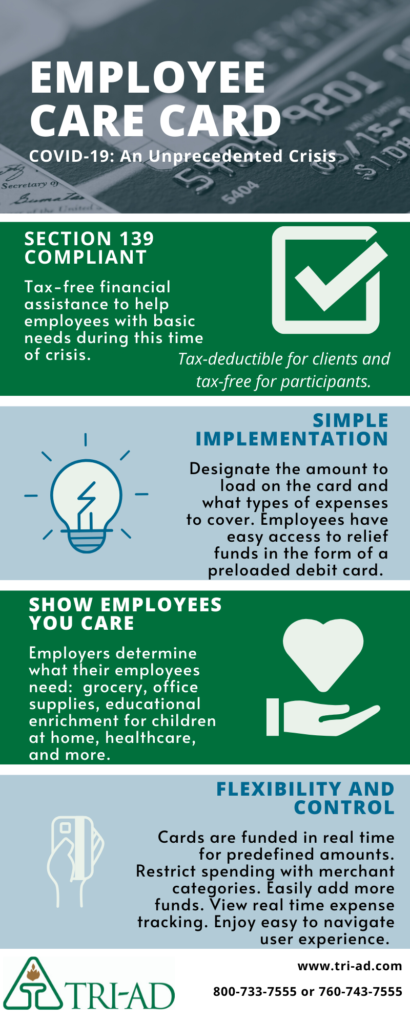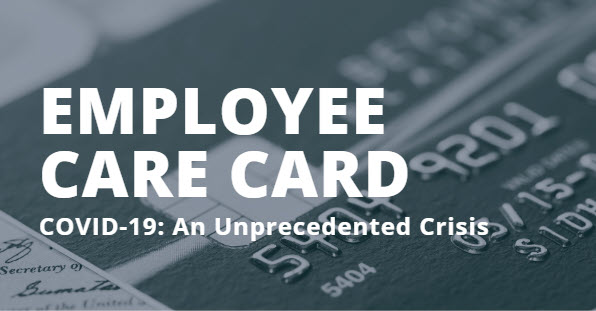The COVID-19 situation is an unparalleled global event that is putting tremendous pressures on people, families, businesses and the economy at large. Many employers are looking for ways to financially support their employees through this crisis – and the most cost-effective way to do so is via a tax-advantaged account. Because the COVID-19 crisis has been designated a national emergency, IRS Code Section 139 permits employers to make tax-free aid payments to employees as “qualified disaster payments.”
Introducing: The Employee Care Card
With this new Section 139-compliant account, you can show employees how much you care by giving them tax-free financial assistance to address some of their most basic needs during this time of crisis. You simply designate the amount you wish to contribute per employee and what type of expenses you want the account to cover. Your employee gets easy access to their relief funds in the form of a convenient debit card – supported by an intuitive and easy-to-navigate online account experience.
More Flexible Than Cash
During this time of financial hardship, distributing tax-free care funds through this method gives you added protection.
- Use tax-advantaged funds. Qualified disaster payments made via the Employee Care Card are tax-free to employees and fully deductible to you as the employer.
- Preserve unused funds. Unlike cash or gift cards, you only pay for what’s used on the cards. Any funds not spent can be returned to you, the employer.
- Control how the dollars are spent. You control when and how the card can be used. This includes restricting purchases to specific merchant types, such as grocery stores or specific types of retailers. This ensures employees are using the funds for services that are deemed most critical.
- Take the burden off internal resources. Much more than a gift card, this comprehensive solution includes tools and support to monitor balances by employee, track tax reporting
How the Employee Care Card Works
Powered by the industry’s most comprehensive benefit platforms, this employee care card program is supported by best-in-class payment capabilities designed to give you total control over how your dollars are spent:
- Funding flexibility. Fund participant accounts in real time and to predefined amounts per employee.
- Impose spending limits/controls. Restrict spending to certain merchant categories, such as groceries or office supplies.
- Easily add more contributions. Should the COVID-19 crisis become prolonged, employers can easily add more dollars to the card.
- Real-time expense tracking. Gain a real-time view into where and how employees are spending their care dollars.
- Intuitive experience. Easy-to-navigate online experience ensures employees have easy access to the answers they need, such as their card balance.
Examples of Assistance Programs
You know your employees best of all – you determine what type of care they need most. These are only a few examples:
- Grocery – employees can stock up on necessities to stay and work at home (including toilet paper!)
- Office supplies – employees can enhance their work-from-home environment for optimal productivity
- Education – parents can occupy and provide enriching activities to children that are home from school
- Healthcare – in the face of a major healthcare crisis, supplement employee healthcare savings with additional dollars
Show Employees You Care
During trying times such as these, employees will look to their employers for help and support. Show your employees how much you care by making tax-free disaster recovery payments via the convenient and easy-to-use Employee Care Card. Align your tax-free financial assistance program to your employee needs while giving your organization maximum flexibility and value.
TRI-AD and our Associates’ suggestions or recommendations shall not constitute legal advice. No content on our website can be construed as tax or legal advice and TRI-AD may not be considered your legal counsel or tax advisor. Clients are encouraged to consult with their tax advisor and/or attorney to determine their legal rights, responsibilities, and liabilities. This includes the interpretation of any statute or regulation, federal, state or local; and/or its application to the clients’ business activities.

